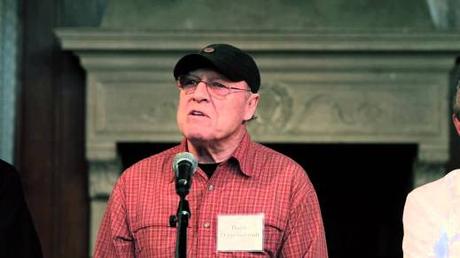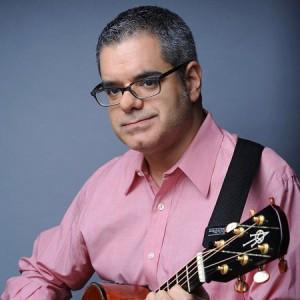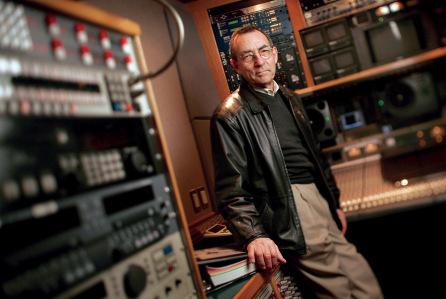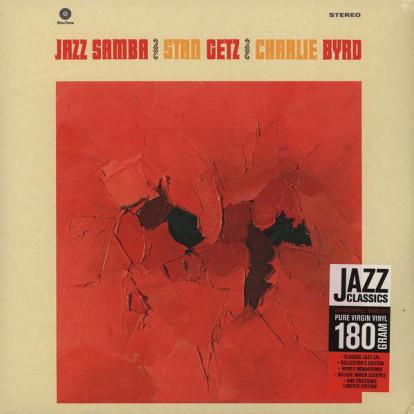Let’s Discuss It!
 Drummer Buddy Deppenschmidt at the Jazz Samba Symposium, June 2014 (Strathmore Music Center)
Drummer Buddy Deppenschmidt at the Jazz Samba Symposium, June 2014 (Strathmore Music Center)
After Ken Avis’s introduction, Leo Lucini started the discussion off with a few words about the roots of Brazilian music, especially the native indigenous sources, mixed in with those of the country’s Portuguese colonizers, and, of course, the African slave influence. He went into a bit of the history of how the descendants of former slaves came together at a street corner called Praça Onze (“Square Eleven”), in Rio, and began to play the rudiments of choro, maxixe, and street samba. From there, later generations of Brazilians, i.e. Jobim, Vinicius, and, in Lucini’s opinion, the “founder” and pioneer of bossa nova, João Gilberto, had also banded together along the beachfront sections known as Ipanema and Copacabana.
Leo paused in his talk to give an active demonstration, involving sections of the audience, of the sounds that comprised the basic samba rhythm. This portion of the program went on a trifle longer than necessary; however, the point was made that samba encompassed a variety of contrasting elements that, together, created the music and rhythm which, when slowed down, gave way to what we know as bossa nova.
The next speaker was David Adler, who wrote the 2004 cover story for JazzTimes on the making of the album Jazz Samba. Most of David’s discussion was centered on his article, but the part that opened most of the audience’s eyes was the sidebar involving the so-called “Phantom Sessions” that allegedly took place prior to Jazz Samba being recorded. Basically, it was an October 1961 session with guitarist Charlie Byrd and saxophonist Stan Getz with Getz’s working quartet at the time, including bassist John Neves and drummer Roy Haynes.

David actually talked to Haynes, who remembered being in the studio with Charlie Byrd before bossa nova became popular. David even sought out and spoke with knowledgeable individuals, several of whom were able to provide specific dates (October 24-26, 1962) for the sessions, although no tapes or supporting material was found. “So there is a Jazz Samba session that’s in the ether somewhere, and it is gone,” David concluded. “It doesn’t exist anymore.” What David drew from this disclosure was the incontrovertible fact that bossa nova required artists who were exposed to the music, who knew it and were capable of playing it. This is where the drummer Buddy Deppenschmidt and bassist Keter Betts came in.
The talk transitioned over to Buddy and his experience with making the now-classic album. He admitted, quite candidly, that “it’s just my version of it, my interpretation of it. It is not pure bossa nova. It’s exactly what the [album] cover says it is. It’s Jazz Samba. It’s the first fusion album before they even started using the word ‘fusion.’ ”
Without realizing it, Buddy had the audience in the palm of his hand from the start. He remained calm and collected throughout the experience. And he showed a canny sense of humor and comic timing when he regaled the crowd with this morsel: “We had no idea [the album] was going to be so successful. Keter Betts said months later, ‘You know that album we did?’ I said, ‘Yeah.’ ‘Well, it got a Grammy.’ And what’s even funnier is, I was 24, and I said, ‘What’s a Grammy?’ I didn’t even know what a Grammy was!”
More controversially, Buddy equated the album’s popular success with, quite possibly, percussionist and second drummer Bill Reichenbach’s placing the emphasis on the rhythm of the songs (which Charlie Byrd selected) on beats two and four, something the “American public was used to hearing” and “could identify with.”
It was now multi-award-winning sound engineer Ed Greene’s turn to discuss his participation in the venture. Ed wasted no time in stressing the fact that a jazz combo, as much as a symphony orchestra, needs to be recorded in an acoustically agreeable environment, not in a “dead room.” It was the raison d’être for recording Jazz Samba at All Souls Unitarian Church in D.C.

True to his profession, Ed emphasized the technical aspects of sound recording, including his use at the time of vacuum tube circuitry, Ampex tape recorders, condensers, and mixers. More important than these was his insistence the musicians be comfortable playing with one another.
It was at that point that Ed turned to Buddy, who he hadn’t seen in over fifty years, and asked, “Were you guys comfortable on stage, playing together?” Buddy replied with a simple “Absolutely,” which he prefaced with “You made my drums sound better than they ever sounded.” This pleased Mr. Greene to no end, who confided to audience members the reason he left the record business, mainly because he got tired of doing guitar overdubs on albums for weeks on end. Again, the musicians had no one to relate to, which in his opinion made the business much too complicated, what with earphones and monitors and such. “It’s a miracle anything comes through at all.” He did say that he enjoyed the immediacy of television, which is where Ed had been thriving for the past several decades, prior to his passing in August 2017.
Returning to the panel discussion at the Strathmore, D.C. native Tom Cole was asked to provide, in response to Ken Avis’ prompt, some context for, as well as the impact of, the album on pop music during and after the 1960s. Turning the tables on the moderator, Tom inquired of the participants that although both instrumental and vocal music were listened to with equal interest, did any of them recall hearing Jazz Samba on the radio; and, if they did, how did they react to it?
Words to the Wise
Ed Greene was the first to interject, in that he still hears the album on the radio. “It’s an unmistakable sound. There’s something about it. The music was not only well played, superbly played. It’s a very sensual music. That’s really what that album’s about. And that’s the essence of bossa nova.” Leo Lucini confirmed Ed’s appraisal, adding “among other things.”
Buddy offered his own thoughts in that he was “pleased that it sounded good. Everything about it was okay, it was correct. I didn’t hear anything that I disliked. And I’m always listening to mistakes that I made. The worst thing about making any recording is that you have to listen to your mistakes over and over and forever.”
What ultimately came out of this phase of the discussion was that the American record-buying public was readily taken with Jazz Samba over earlier recordings that were issued (in some cases, a decade or so earlier), among them Brazilian music featuring guitarist Laurindo Almeida and saxophonist Bud Shank.

A brief question-and-answer session followed, wherein yours truly, who was present in the audience and listening attentively to what was being divulged, was asked by Buddy (thank you, my friend!) to comment on the influence of the movie Black Orpheus in popularizing bossa nova. Here’s the answer I gave the panel:
“Vinicius de Moraes and Jobim wrote the music for the original play, Orfeu da Conceição, which later was turned into a film by Marcel Camus, made in Rio. It included none of the music from the play, but all new music by Jobim, as well as music by Luiz Bonfá. That “The Morning of Carnival” and “Samba de Orfeu” were Bonfá’s music. Black Orpheus is a totally other story. It’s a film that really captured, visually and sonically, the imagination of Americans and pretty much the whole world — except at the time the native Brazilians.”
Although nobody asked me, I volunteered a story that I had read in journalist and writer Ruy Castro’s book, Chega de Saudade (a.k.a. Bossa Nova): “My comment is about Stan Getz, they said he was a great player because of his sound and everything. During the recording sessions of Getz-Gilberto, João Gilberto made a comment to Jobim about it. As Getz was blowing away, Gilberto told Jobim [and I was paraphrasing here], ‘Tell that moron to shut up, he’s playing too loud.’ Jobim saw Stan’s expression and he said, ‘He says he likes the way you play.’ And Getz, in response, said, ‘Funny, I don’t think that’s what he said.’ ”

I was pleased — no, thrilled — to hear that Brazil’s music, especially the soothing sounds of bossa nova, was still seducing audiences the way it had over half a century ago.
Looking back on the previous Friday night’s concert with Eliane Elias and Sergio Mendes, I was reminded of an elderly gentleman seated to my right. He had come into the Strathmore Music Center with the aid of a walker, so fragile and weak was his appearance. The man must have been in his eighties. He was accompanied by his wife, who looked about a decade younger.
As the music and vibes reached their peak, the man stood up and, to my astonishment, started jerking his arms around in time to the rhythm. He was hardly able to keep up with the music, but boy, was he having the time of his life! Fond memories of his younger and healthier self must have been on his mind.
Then it dawned on me. Bossa nova continues to charm the world. And based on what I witnessed that night, it never really gets old, does it?
Copyright © 2018 by Josmar F. Lopes
Advertisements &b; &b;
